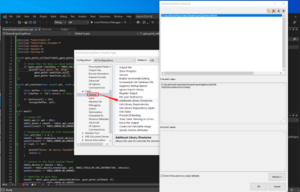Extract the archive containing the library and all necessary header files, then follow the steps below to integrate StreamEngine into your application.
1. Create a new project (Console App)

2. Configure your new project

3. Paste the sample code below into the cpp file
#include "tobii/tobii.h"
#include "tobii/tobii_streams.h"
#include <stdio.h>
#include <assert.h>
#include <string.h>
void gaze_point_callback( tobii_gaze_point_t const* gaze_point, void* /* user_data */)
{
// Check that the data is valid before using it
if( gaze_point->validity == TOBII_VALIDITY_VALID )
printf( "Gaze point: %f, %f\n",
gaze_point->position_xy[ 0 ],
gaze_point->position_xy[ 1 ] );
}
void url_receiver( char const* url, void* user_data )
{
char* buffer = (char*)user_data;
if( *buffer != '\0' ) return; // only keep first value
if( strlen( url ) < 256 )
strcpy( buffer, url );
}
int main()
{
// Create API
tobii_api_t* api = NULL;
tobii_error_t result = tobii_api_create( &api, NULL, NULL );
assert( result == TOBII_ERROR_NO_ERROR );
// Enumerate devices to find connected eye trackers, keep the first
char url[ 256 ] = { 0 };
result = tobii_enumerate_local_device_urls( api, url_receiver, url );
assert( result == TOBII_ERROR_NO_ERROR );
if(*url == '\0')
{
printf("Error: No device found\n");
return 1;
}
// Connect to the first tracker found
tobii_device_t* device = NULL;
result = tobii_device_create( api, url, TOBII_FIELD_OF_USE_STORE_OR_TRANSFER_FALSE, &device );
assert( result == TOBII_ERROR_NO_ERROR );
// Subscribe to gaze data
result = tobii_gaze_point_subscribe( device, gaze_point_callback, 0 );
assert( result == TOBII_ERROR_NO_ERROR );
// This sample will collect 1000 gaze points
for( int i=0; i<1000; i++ )
{
// Optionally block this thread until data is available. Especially useful if running in a separate thread.
result = tobii_wait_for_callbacks( 1, &device );
assert( result == TOBII_ERROR_NO_ERROR || result == TOBII_ERROR_TIMED_OUT );
// Process callbacks on this thread if data is available
result = tobii_device_process_callbacks( device );
assert( result == TOBII_ERROR_NO_ERROR );
}
// Cleanup
result = tobii_gaze_point_unsubscribe( device );
assert( result == TOBII_ERROR_NO_ERROR );
result = tobii_device_destroy( device );
assert( result == TOBII_ERROR_NO_ERROR );
result = tobii_api_destroy( api );
assert( result == TOBII_ERROR_NO_ERROR );
return 0;
}4. Right-click the project -> Properties -> Configuration Properties -> C/C++ -> General -> Additional Include Directories
Add the include folder path

5. Configuration Properties -> Linker -> General -> Additional Library Directories
Add the lib folder path

6. Configuration Properties -> Linker -> Input -> Additional Dependencies
Add the lib name: tobii_stream_engine.lib

7. Run and receive the gaze data!

8. If you happen to receive this error, add “using namespace std” in the sample script

